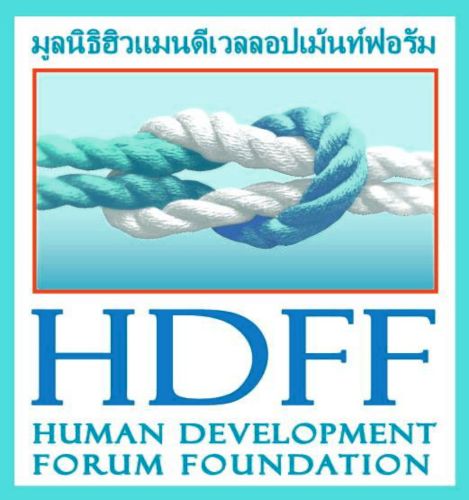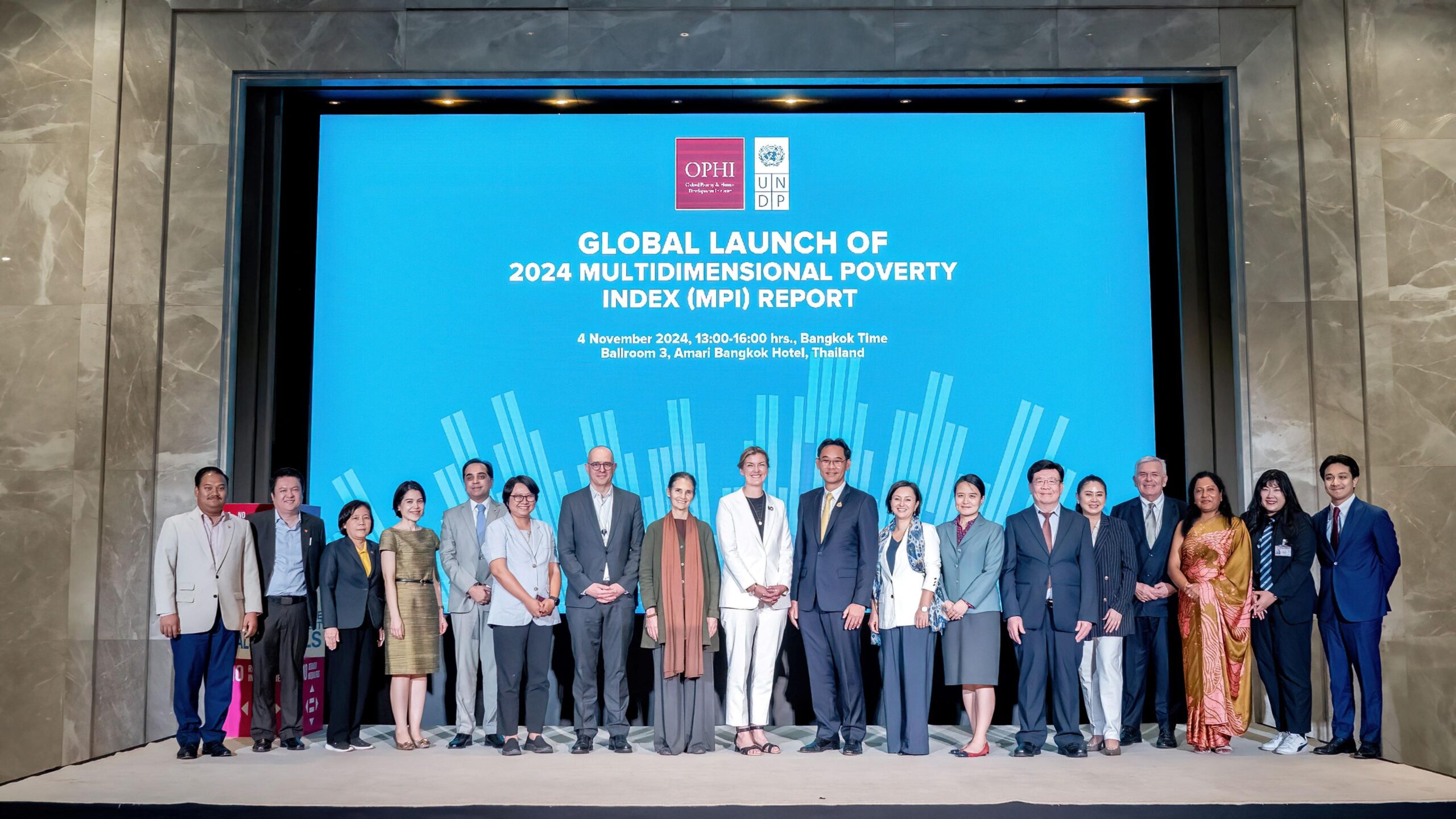On Monday, November 4 2024, the HDFF team attended the first launch of the 2024 Multidimensional Poverty Index (MPI) Report, presented by the United Nations Development Programme (UNDP) and the Oxford Poverty & Human Development Initiative (OPHI) (1). This year’s theme, Poverty Amid Conflict, underscored the important intersection between poverty and conflict.
The Global MPI is a measuring tool assessing multidimensional poverty across 112 countries, supporting Sustainable Development Goal 1 to end poverty in all forms, and captures overlapping deprivations across several areas tied to SDGs 1, 2, 3, 4, 6, 7, and 11.
Welcoming remarks by Ms. Niamh Collier-Smith, Resident Representative to UNDP Thailand
Ms. Niamh Collier-Smith, UNDP Thailand’s Resident Representative, introduced the MPI, which assesses 10 indicators to measure poverty across education, health, and living standards like housing, water, sanitation, and electricity. It highlights who faces deprivations, where they are, and the barriers to well-being. She also discussed Thailand’s progress in reducing poverty, though regional disparities remain, as noted in the NESDC Report.
Opening video presentation by Mr. Achim Steiner, UNDP Administrator
Mr. Achim Steiner, UNDP Administrator, emphasized the importance of exploring beyond income to understand poverty and highlighted a new focus in this year’s report: the intersection of poverty and violent conflict. The MPI reveals not only who experiences poverty but also how they are affected, providing insights into the policies most effective in addressing their unique challenges. This year’s report underscores that peace is essential for these efforts to succeed.
Multidimensional Poverty Index (MPI) – Poverty Amid Conflict 2024
Dr. Sabina Alkire, Director of the Oxford Poverty and Human Development Initiative (OPHI), University of Oxford and Ms. Yanchun Zhang, Human Development Report Office, UNDP presented the key findings from the report (2):
- Across the 112 countries included in this report, 1.1 billion people (18.3 percent) live in acute multidimensional poverty.
- Half of them are children under the age of 18 (584 million). Globally, 29.7 percent of children live in poverty, compared with 13.5 percent of adults.
- 83.7 percent live in rural areas. Across all world regions people in rural areas are poorer than people in urban areas.
- 83.2 percent live in Sub-Saharan Africa and South Asia, with respectively 522 million people and 402 million.
- Nearly two-thirds of poor people live in middle-income countries (749 million, 65.2 percent).
The MPI methodology was explained, where data is collected from the Uppsala Conflict Data Program UCDP), the World Bank’s list of fragile and conflict-affected situations (FCS), and the Institute for Economics and Peace’s Global Peace Index (GPI). The analysis shows that poverty rates are highest in conflict-affected states.
Poverty and conflict create a vicious cycle: currently, 10% of the global population lives in war-affected countries, where deprivation is markedly higher across all MPI indicators. The impacts are particularly severe in areas like nutrition, electricity, water, and sanitation. Conflict also significantly hinders poverty reduction efforts, making it far harder for these states to achieve SDG 1 and eradicate poverty.
Afghanistan was used as a case study, covering the period from 2015/16 to 2022/23, and showing how poverty rates have increased due to worsening conditions in both rural and urban areas. Deprivation rose in most indicators, especially in education and asset ownership. The increase in poverty was especially significant among children, with a 7-percentage point rise compared to a 3-percentage point increase among adults.
Seven ASEAN countries are included in the MPI Report. Thailand has the lowest level of acute poverty in ASEAN, indicating the region’s best poverty situation. Cambodia was highlighted as an example where policies cannot be applied uniformly, as poverty levels vary widely across its subnational regions. It was emphasized that this is an important consideration for other countries as well.
Special Lecture on Peace, Poverty Eradication, and Thailand’s Way Forward by Mr. Danucha Pichayanan, Secretary General, Office of the National Economic and Social Development Council
The presentation covered Thailand’s National Multidimensional Poverty Index (MPI), which evaluates poverty across 12 indicators in four areas: Education, Health, Living Conditions, and Financial Security. Data from 2012 to 2023 show progress, however, 7% of the population remains affected by MPI poverty.
Regional disparities are significant, with the highest poverty rates in Narathiwat, Surin, Mae Hong Son, Uthai Thani, and Pattani, particularly in border areas facing challenges like limited access to resources and ongoing unrest. In contrast, provinces like Nonthaburi, Rayong, Samut Prakan, Bangkok, and Nakhon Pathom perform the best.
The presentation introduced the Child MPI (C-MPI), developed with UNICEF Thailand, to assess child poverty across 10 indicators in Education, Child Welfare, Living Standards, and Health. From 2016-2019, C-MPI decreased, but in 2019, one in five children still faced multidimensional poverty, with education being the key factor. The northeastern region had the highest child poverty rates, followed by the south, where children experience greater deprivation. Children aged 0-4 are most affected, with 44% living in poverty. Thailand’s 15-year free education system has been a key factor in reducing child poverty.
The Thai People Map and Analytics Platform (TPMAP MPI) was introduced to identify individuals, households, and communities at the provincial level for targeted interventions. Integrated with the Multidimensional Poverty Index (MPI), TPMAP helps address poverty more effectively.
The recommended strategies for advancing N-MPI objectives are as follows:
1. Inform policies and interventions with MPI data to ensure they are evidence-based and address the root causes of poverty effectively.
2. Improve indicators and data collection to enable precise targeting and to develop robust metrics for measuring policy impact, ensuring accurate progress tracking and timely adjustments.
3. Customize policies to address unique regional challenges. For example, specific policies are implemented for three Southern border provinces, allowing for sustainable, data-driven development in each area.
Panel Discussion on Alleviating Multidimensional Poverty Amid Conflicts: Global Lessons and Implications for Thailand
Moderator: Ms. Thanchanok Jongyotying, Chief News Editor, TNN
Panelist:
- Dr. Ulrich Schmitt, Manager, World Bank Thailand and Myanmar
- Dr. Sompop Manarungsan, President, Panyapiwat Institute of Management
- Ms. Warangkana Rattanarat, Country Program Director, RECOFTC
- Ms. Finda Koroma, Chief Executive Officer of Africa Human Capital Development Plus and the Executive Director of F.K. Consulting Inc.
Could you elaborate on the link between poverty and conflict in the African context, and how conflict adds challenges to poverty eradication? (Directed to Ms. Finda Koroma)
Conflict is a major barrier to poverty reduction, as it destroys infrastructure, disrupts services, and displaces communities. For low-income countries, it also strains resources, weakens governance, and complicates equitable resource distribution. Additionally, conflict-affected areas often lack reliable data, experience human capital loss due to limited access to education and healthcare and face economic isolation from blockades or sanctions. The resulting displacement and psychological trauma further reduce individuals’ ability to engage in economic activities, creating significant obstacles to overcoming poverty. Lastly, conflict and insecurity often restrict humanitarian access which further complicates poverty reduction efforts.
How have global, regional, and domestic geopolitical uncertainties complicated poverty reduction efforts in Southeast Asia? (Directed to Dr. Ulrich Schmitt)
Dr. Schmitt began on a high note by stating the steady growth and broadly shared benefits across East Asia and the Pacific, despite COVID-19 disruptions and geopolitical tensions. While this is positive for the region, the economic recovery remains underwhelming compared to pre-COVID levels. Indonesia stands out as the only Southeast Asian country to fully recover economically. Moving forward, countries will need to pursue reforms and identify new drivers of growth.
Economic growth has been key to poverty reduction in East Asia, especially in China, which has lifted 800 million people out of poverty over the last 40 years. Thailand also exemplifies a similar path to success. However, Myanmar presents a contrast: its economy is now 10% smaller than pre-2021 coup levels, and urban poverty is increasing even among the most educated. Myanmar’s line diverges severely from the broader regional progress in Southeast Asia.
How are Thailand’s domestic issues, such as poverty in the southern regions, combined with global geopolitical tensions, impacting its socio-economic prospects? (Directed to Dr. Sompop Manarungsan)
If conflicts were to escalate between superpowers, whether Western or Eastern, Thailand would be affected both directly and indirectly. In response, Thailand must consider how to balance relations among competing powers through a neutral, non-aligned diplomatic approach, which is essential for development. Furthermore, regional collaboration is now more important than global alliances. Strengthening partnerships within ASEAN, also with neighbors like Myanmar, should be prioritized, focusing on collective security and economic resilience to support Thailand’s socio-economic stability.
What challenges do communities face in reducing poverty and promoting equal opportunities? (Directed to Ms. Warangkana Rattanarat)
Ms. Rattanarat emphasized the importance of listening to grassroots perspectives on conflict, noting that “silent conflicts,” such as disputes over natural resources, are often overlooked. She highlighted the RECOFTC project, Poverty by Law, showing how insecure land tenure can perpetuate poverty, especially for communities reliant on natural resources. She pointed out that there’s insufficient political will to address these forms of poverty, as policies often overlook non-monetary aspects, and that laws often fail to recognize sustainable local resource use. There is a need to realize that natural resources belong to local communities. Increased investment in sustainable resources, such as forests, is crucial for addressing poverty comprehensively and empowering local communities.
What actions are needed to restore peace and support sustainable recovery in conflict-affected countries in Africa? (Directed to Ms. Finda Koroma)
Ms. Koroma highlighted a comprehensive approach for sustainable recovery in conflict-affected African countries, starting with investments in education and healthcare to build resilience. Addressing root causes of conflict, strengthening governance, and focusing on the needs of vulnerable groups, especially women and children, are crucial for stability. She emphasized the importance of peace-building initiatives, like promoting dialogue, and noted successes in Ghana and Rwanda. Additionally, she underscored the need for better data collection, accountability, and international partnerships, not only to restore peace but to create foundations for sustainable growth.
What key global lessons can Southeast Asian countries, including Thailand, adopt to strengthen peacebuilding to promote poverty eradication and inclusive growth at national and subnational level? (Directed to Dr. Ulrich Schmitt)
In Myanmar, the World Bank has adapted its approach to suit the challenging conflict environment. Given the absence of a clear path to conflict resolution, the World Bank has shifted away from traditional operations, focusing instead on analytical programs and targeting aid to vulnerable communities through donor resources. Flexibility in geographic focus and the ability to adjust interventions are essential, as is reliance on partners with strong local capacities, in Myanmar it is particularly UN agencies. A key takeaway from the World Bank’s experience is the importance of combining short-term humanitarian interventions with longer-term resilience-building efforts. The World Bank refers to this as “The Resilience Spectrum,” a phased approach that begins with immediate relief and gradually transitions to initiatives that foster resilience over time.
Thailand has a long history of grievances in its southern provinces, particularly among Muslim communities. To address these, Thailand could seek a regional common ground development agenda, focused on skill-building, inclusion, and addressing long standing grievances. Promoting women’s economic participation is also key. Unlike Myanmar’s immediate interventions, Thailand should emphasize longer-term, sustainable solutions to foster lasting peace and growth.
(Alva Lange is a Research Fellow at HDFF)
Sources:
1: https://www.youtube.com/watch?v=UUpVGyATXvw
2: https://hdr.undp.org/system/files/documents/hdp-document/mpireport2024en.pdf


Comments are closed